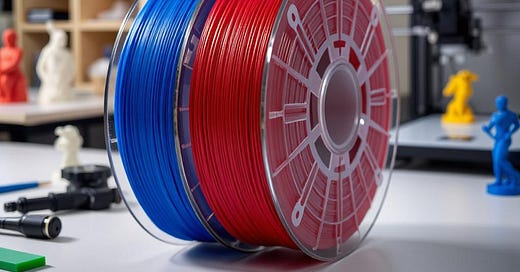The Ultimate Guide to PLA Filament in 3D Printing: A Deep Dive into the Biodegradable Wonder
3D printing has revolutionized the way we create, prototype, and innovate. At the heart of this revolution lies a material that has become synonymous with accessibility, ease of use, and environmental consciousness: Polylactic Acid (PLA). PLA filament is the go-to choice for beginners and professionals alike, offering a unique combination of biodegradability, printability, and versatility. In this article, we’ll explore PLA in depth—its properties, applications, advantages, limitations, and the future of this remarkable material.
What is PLA?
PLA, or Polylactic Acid, is a biodegradable thermoplastic derived from renewable resources such as corn starch, sugarcane, or tapioca roots. Unlike petroleum-based plastics like ABS, PLA is part of the biopolymer family, making it a more sustainable option for 3D printing. Its origins in natural resources give it a unique edge in an era where environmental concerns are at the forefront of technological innovation.
Why PLA is the King of 3D Printing Filaments
PLA’s popularity stems from its user-friendly nature and excellent print quality. Here’s why it’s the most widely used filament in the 3D printing community:
Ease of Printing:
PLA has a low printing temperature (180–220°C), reducing the risk of nozzle clogging and making it compatible with most FDM printers.
It exhibits minimal warping, eliminating the need for an enclosed print chamber or advanced bed adhesion techniques.
Environmental Benefits:
PLA is biodegradable under industrial composting conditions, breaking down into lactic acid, water, and carbon dioxide.
Its production consumes less energy compared to traditional plastics, further reducing its carbon footprint.
Aesthetic Appeal:
PLA produces smooth, glossy prints with fine details, making it ideal for decorative items, figurines, and prototypes.
It is available in a wide range of colors, finishes (matte, metallic, translucent), and specialty blends (e.g., wood-filled, glow-in-the-dark).
Safety:
PLA emits a mild, sweet odor during printing, unlike the strong fumes of ABS or nylon.
It is considered food-safe, though proper post-processing and nozzle materials are required for food-contact applications.
Applications of PLA in 3D Printing
PLA’s versatility makes it suitable for a wide range of applications:
Prototyping:
PLA is ideal for creating concept models and prototypes due to its ease of use and ability to produce fine details.
Art and Design:
Artists and designers use PLA to create intricate sculptures, jewelry, and home decor items.
Education:
PLA’s low toxicity and ease of printing make it a popular choice for schools and workshops.
Functional Parts:
While PLA is not as durable as ABS or PETG, it can be used for lightweight functional parts that don’t require high heat resistance or mechanical stress.
Specialty Projects:
Specialty PLA filaments, such as wood-filled or metal-filled PLA, open up new possibilities for creative and functional projects.
The Science Behind PLA: Properties and Performance
Understanding PLA’s material properties is key to unlocking its full potential:
Strength and Rigidity: PLA is stiff and has good tensile strength, but it is more brittle than ABS or PETG. This makes it less suitable for parts that require flexibility or impact resistance.
Heat Resistance: PLA softens at temperatures above 60°C, limiting its use in high-temperature environments.
Biodegradability: PLA breaks down under industrial composting conditions, but it may persist in landfills or home composts due to the lack of controlled environments.
Moisture Sensitivity: PLA absorbs moisture from the air, which can lead to poor print quality. Proper storage is essential to maintain its performance.
Challenges and Limitations of PLA
While PLA is a fantastic material, it does have some drawbacks:
Brittleness:
PLA’s rigidity makes it prone to cracking under stress, limiting its use in high-impact applications.
Low Heat Resistance:
PLA parts can deform when exposed to high temperatures, making it unsuitable for applications like automotive components or outdoor use.
Degradation Over Time:
PLA can degrade when exposed to UV light and moisture, reducing its lifespan in outdoor environments.
Recycling Challenges:
While PLA is technically recyclable, it requires specialized facilities, which are not widely available.
Maximizing PLA’s Potential: Tips and Tricks
To get the most out of PLA, follow these best practices:
Optimal Print Settings:
Use a nozzle temperature of 180–220°C and a bed temperature of 50–60°C for best results.
Enable cooling fans to improve layer adhesion and surface finish.
Bed Adhesion:
Use a clean print bed with adhesion aids like painter’s tape, glue sticks, or PEI sheets.
Post-Processing:
Sand PLA prints with fine-grit sandpaper for a smooth finish.
Use acrylic paints or spray paints to add color and detail.
Consider annealing (heat treatment) to improve strength and heat resistance, though this may cause slight warping.
Storage:
Store PLA in an airtight container with desiccant packs to prevent moisture absorption.
The Future of PLA: Innovations and Sustainability
As the 3D printing industry evolves, so does PLA. Researchers and manufacturers are working on new formulations to address its limitations:
PLA+:
Enhanced PLA with added modifiers for improved strength, flexibility, and layer adhesion.
Blended Filaments:
PLA blended with materials like wood, metal, or carbon fiber for unique properties and aesthetics.
Recycling Initiatives:
Efforts to develop more efficient recycling methods for PLA to reduce waste.
Biodegradable Composites:
New composites that combine PLA with other biodegradable materials for enhanced performance.
Conclusion: PLA as a Gateway to Sustainable Innovation
PLA filament has earned its place as the most popular material in 3D printing, thanks to its ease of use, environmental benefits, and versatility. While it may not be perfect, its strengths far outweigh its limitations, making it an excellent choice for a wide range of applications. As the industry continues to innovate, PLA will likely remain at the forefront of sustainable 3D printing, paving the way for a greener, more creative future.
Whether you’re a beginner exploring the world of 3D printing or a seasoned professional looking for a reliable material, PLA is a filament that delivers on its promises. By understanding its properties, optimizing your printing process, and exploring its potential, you can unlock endless possibilities with this biodegradable wonder.




